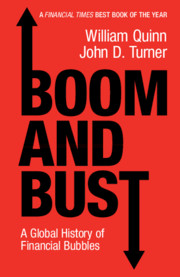Book contents
- Boom and Bust
- Boom and Bust
- Copyright page
- Contents
- Figures
- Tables
- Chapter 1 The Bubble Triangle
- Chapter 2 1720 and the Invention of the Bubble
- Chapter 3 Marketability Revived: The First Emerging Market Bubble
- Chapter 4 Democratising Speculation: The Great Railway Mania
- Chapter 5 Other People’s Money: The Australian Land Boom
- Chapter 6 Wheeler-Dealers: The British Bicycle Mania
- Chapter 7 The Roaring Twenties and the Wall Street Crash
- Chapter 8 Blowing Bubbles for Political Purposes: Japan in the 1980s
- Chapter 9 The Dot-Com Bubble
- Chapter 10 ‘No More Boom and Bust’: The Subprime Bubble
- Chapter 11 Casino Capitalism with Chinese Characteristics
- Chapter 12 Predicting Bubbles
- Acknowledgements
- Notes
- Bibliography
- Index
Chapter 6 - Wheeler-Dealers: The British Bicycle Mania
Published online by Cambridge University Press: 06 August 2020
- Boom and Bust
- Boom and Bust
- Copyright page
- Contents
- Figures
- Tables
- Chapter 1 The Bubble Triangle
- Chapter 2 1720 and the Invention of the Bubble
- Chapter 3 Marketability Revived: The First Emerging Market Bubble
- Chapter 4 Democratising Speculation: The Great Railway Mania
- Chapter 5 Other People’s Money: The Australian Land Boom
- Chapter 6 Wheeler-Dealers: The British Bicycle Mania
- Chapter 7 The Roaring Twenties and the Wall Street Crash
- Chapter 8 Blowing Bubbles for Political Purposes: Japan in the 1980s
- Chapter 9 The Dot-Com Bubble
- Chapter 10 ‘No More Boom and Bust’: The Subprime Bubble
- Chapter 11 Casino Capitalism with Chinese Characteristics
- Chapter 12 Predicting Bubbles
- Acknowledgements
- Notes
- Bibliography
- Index
Summary
Chapter 6 examines the bubble that occurred in the UK bicycle company shares in the 1890s. The modern bicycle emerged in the late 1880s after a series of revolutionary technological innovations, ranging from the pneumatic tyre to weldless steel tubes. Between 1895 and 1897, nearly 700 cycle companies were floated on the stock exchange, many of which were promoted by very questionable characters. An index of cycle shares appreciated 258 per cent in the first five months of 1896. The index remained high until the early months of 1897. By the end of 1898, the index was 71 per cent below its peak. The chapter then moves on to explore how the bubble triangle and the spark provided by the new technology explains the British bicycle mania. Marketability was high because so many cycle companies had floated their shares on the stock market and these shares had very low denominations. Monetary conditions were as loose as they ever had been up to that point and returns on traditional assets were very low. Speculation was rampant, but the presence of corners limited speculation in the opposite direction. The chapter concludes by arguing that the bicycle mania is a good example of a useful bubble.
- Type
- Chapter
- Information
- Boom and BustA Global History of Financial Bubbles, pp. 98 - 114Publisher: Cambridge University PressPrint publication year: 2020



